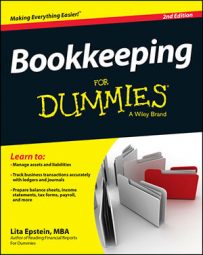Many business owners think of bookkeeping as a necessary evil, but in reality, if you make effective use of the data you collect, bookkeeping can be your best buddy when it comes to managing your cash. The key to taking advantage of what bookkeeping has to offer is understanding the value of basic bookkeeping principles and using information collected.
Charting the way
You may not think that a list of accounts, called the Chart of Accounts, is worth much attention, but this chart dictates how you collect your financial data and where in the books you put your company’s transactions. In order for you to be able to use the information effectively, it’s crucial that your Chart of Accounts defines each account precisely and determines exactly what types of transactions go where.
Balancing your entries
Balanced books are the only way to know how your business is doing. Without them, you can never know whether your profit numbers are accurate. In bookkeeping, you use a process called double-entry bookkeeping to keep the books balanced.
Posting your transactions
In order to be able to use the information you collect regarding your business transactions, the transactions must be posted accurately to your accounts. If you forget to post a transaction to your books, your reports won’t reflect that financial activity, and that’s a serious problem. Or, if you post an incorrect transaction to your books, any reports that draw on information will be wrong — again, a problem.
Tracking customer collections
If your business sells to customers on store credit, you certainly want to be sure your customers pay for their purchases in the future. (Customer account information is gathered in the Accounts Receivable account as well as in individual records for each customer.)
You should review reports based on customer payment history, called aging reports, on a monthly basis to be sure customers pay on time. Remember that you set the rules for store credit, so you may want to cut off customers from future purchases if their accounts are past due for 90 days or more.
Paying bills accurately and on time
If you want to continue getting supplies, products, and services from your vendors and contractors, you must pay them accurately and on time. Managing your payments through the Accounts Payable account ensures accuracy and timeliness, and it also saves you from mistakenly paying bills twice. To be safe, you should review aging reports on your payment history to see that your bookkeeper is making timely and accurate payments.
Planning profits
Nothing is more important to a business owner than the profits he will ultimately make. Yet many business owners don’t take time to plan their profit expectations at the beginning of each year, so they have no way to gauge how well their businesses do throughout the year.
Avoid this problem by taking time before the year starts to develop profit expectations and a budget that will help you meet those expectations. Then develop a series of internal financial reports from the numbers in your bookkeeping system to help determine whether or not you’re meeting your sales targets and maintaining control over your product costs and operating expenses.
Comparing budget to actual expenses
Keeping a careful watch on how well your budget planning reflects what’s actually happening in your business can help you meet your profit goals. As with profits (see the preceding section), take time to develop a budget that sets your expectations for the year, and then develop internal reports that give you the ability to track how closely your actual expenses match that budget.
If you see any major problems, correct them as soon as possible to be sure you meet your target profit at the end of the year.
Comparing sales goals to actual sales
In addition to watching your expenses, you also need to monitor your actual sales so that they match the sales goals you set at the beginning of the year. Designing an internal report that tracks sales goals versus actual sales allows you to monitor how well your business is doing.
If you find your actual sales are below expectations, correct the problem as early in the year as possible in order to improve your chances of meeting those year-end goals.
Tracking cost trends
Awareness of the costs involved in purchasing the products you sell or the raw materials you use to manufacture your products is very important because these cost trends can have a major impact on whether or not your company earns the net income you expect. If you find that the costs are trending upward, you may need to adjust the prices of the products you sell in order to meet your profit goals.
Making pricing decisions
Properly pricing your product can be a critical factor in determining whether or not your product sells. If the price is too high, you may not find any customers willing to buy the product; if it’s too low, you lose money.
When determining what price to charge your customers, you must consider a number of different factors, including how much you pay to buy or manufacture the products you sell, market research about what customers will pay for a product, what you pay your employees, and advertising and administrative expenses you incur in order to set a price. All these items are factors in what you’ll spend to sell that product.

